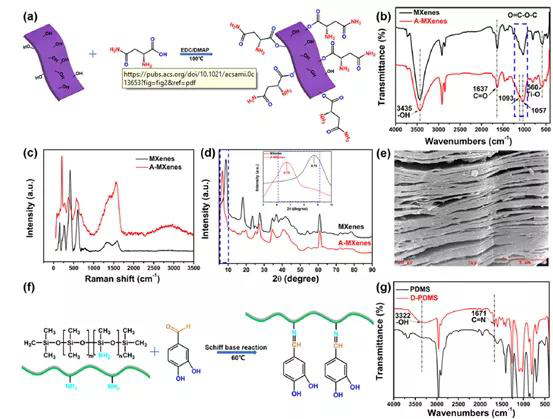


In the past few decades, flexible sensors have been widely used in medical monitoring, robotics, human-computer interaction and other fields. However, during use, the sensor will inevitably be mechanically damaged, causing cracks, scratches or even disconnection on the surface. These structural damages may cause the sensor to lose its normal function. Therefore, the development of self-healing flexible wearable sensors is of great significance to maintain its stability and function.

Recently, Professor Liu Yuetao of Qingdao University of Science and Technology published a research paper titled: Self-Healing Ti3C2 MXene/PDMS Supramolecular Elastomers Based on Small Biomolecules Modification for Wearable Sensors in the internationally renowned academic journal ACS Applied Materials & Interfaces. The self-healing Ti3C2MXene/PDMS supramolecular elastomer based on the interaction between biomolecules has excellent mechanical properties, stability and electrical sensitivity, and explores its application value in the field of wearable sensors. Using Liliaceae D-asparagine as raw material, MXenes is modified by esterification of carboxyl and hydroxyl groups. At the same time, the Schiff base reaction was used to graft 3,4-dihydroxybenzaldehyde in forest and grass plants to PDMS macromolecules with amino groups through imine bonds. A-MXene/D-PDMS elastomer can self-heal at room temperature under the action of hydrogen bond and imine bond after breaking. After the repair, the mechanical and electrical properties are almost completely restored. Because A-MXenes is uniformly dispersed in the polymer system, the composite has good electrical conductivity and sensitivity to changes in stress state. Even the repaired material can successfully monitor the large and subtle movements of human muscles. Therefore, self-healing conductive composite materials modified by biomolecules can be used as a reliable platform and have application potential in the fields of motion monitoring and speech recognition.


Figure 1. The main preparation process of A-MXene/D-PDMS elastomer and the interaction between A-MXene and D-PDMS.

Figure 2. Physical characterization of materials.

Figure 3. Characterization of mechanical properties before and after fracture healing.

Figure 4. Characterization of electrical properties before and after fracture healing.

Figure 5. Human activity monitoring before and after fracture healing.

In summary, this study designed a self-healing Ti3C2MXene/PDMS supramolecular elastomer based on the interaction between biomolecules. MXenes was modified by esterification and PDMS was grafted by Schiff base reaction. A-MXenes and D-PDMS supramolecules can interact with hydrogen bonds. Conductive composite materials exhibit good tensile properties and self-healing ability at room temperature. After 24 hours of repair, the tensile strength and conductivity of 10wt% A-MXenes/D-PDMS recovered to 98.4 and 97.6%, respectively. Conductive composites exhibit a linear and sensitive response to tension. In addition, it can also detect the activities of various joints and muscles of the human body, showing great potential in wearable sensing devices. In addition, the innovative preparation method of the MXene/PDMS composite system in this paper has important guiding significance for the design of non-healing conductive elastomers.
Literature link:
https://doi.org/10.1021/acsami.0c13653.
Information source: MXene Frontier
This information is from the Internet for academic exchanges. If there is any infringement, please contact us and delete it immediately












